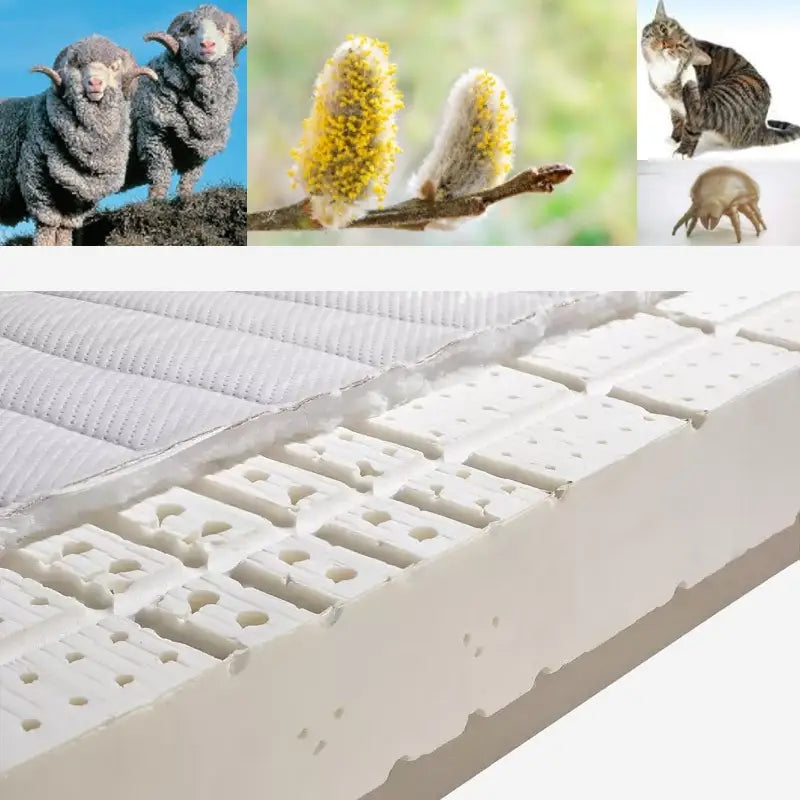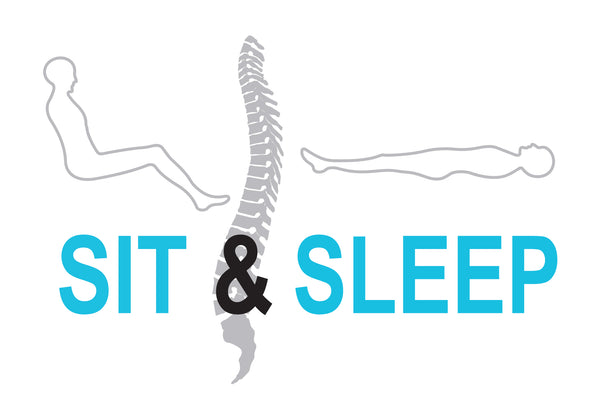
Allergies that disrupt your sleep quality
An allergy can negatively impact your sleep quality if left unchecked. Most people know which materials they're allergic to or sensitive to. For those experiencing poor sleep, it's certainly worth considering whether or not an allergy is affecting them.
Are you experiencing one or more of the symptoms below? Be sure to consult your doctor to rule out or diagnose an allergy so you can take the necessary steps.
General allergy symptoms are very broad and can trigger one or more of the following symptoms:
- itching or spots on the (entire) skin
- allergic eczema
- swollen eyelids
- swollen whites of the eyes
- watery eyes
- tickle in the nose
- tingling of the tongue
- sneezing
- runny nose
- coughing, wheezing or shortness of breath may indicate an allergy (asthma symptoms)
- vomiting, diarrhea, abdominal complaints
- sore throat
- shortness of breath
What types of (sleep-related) allergies are there?
-
Latex allergy : There are different types of latex allergy, and the symptoms vary depending on the type.
The first type of latex allergy causes symptoms around the nose, lungs, and eyes. This form can cause more severe symptoms, such as abdominal cramps, nausea, and dizziness. In the most extreme form, anaphylactic shock can occur.
The second type is the well-known contact allergy, where symptoms often occur after (prolonged) contact with latex products and the symptoms manifest locally on the skin as itching, redness, swelling, blisters, flaking, skin thickening and possibly even scratch wounds. - Wool allergy : A wool allergy doesn't actually exist. Wool can cause irritation, and this is related to the size of the fiber, not the material itself. A large fiber causes a local irritation on the skin. A true allergy is a wool grease allergy. Wool grease is the waxy substance secreted by the animal's sebaceous glands, which causes allergic contact dermatitis. Wool grease is mainly found in cosmetic and pharmaceutical products and therefore not applicable to sleep.
- House dust mite allergy : With a house dust mite allergy, you are allergic to the droppings of dust mites. A house dust mite is a 0.3mm arachnid that feeds on skin flakes and is present in every bedroom. They have a lifespan of 2 to 3 months and reproduce every 3 to 4 weeks. They are most commonly found in dust particles from house dust, carpets, bedding, upholstery, and curtains.
- Pet dander allergy : With a pet allergy, symptoms are caused by a reaction to animal dander and feathers. Allergens are also present in animal saliva and urine. Inhaling these allergens triggers allergy symptoms. Cat and dog allergies are the most common, with symptoms primarily affecting the mucous membranes of the nose, eyes, and lungs. If your pet regularly spends time in the bedroom and you have an allergic reaction to it, this can also impact your sleep.
- Is a pollen allergy relevant from the perspective of sleep and sleep? Pollen allergy is better known as hay fever. Symptoms of hay fever are caused by pollen from certain grasses, plants, or trees. These symptoms arise when pollen gets in your eyes, nose, mouth, throat, or trachea. This causes the mucous membranes to thicken and produce more mucus. Hay fever symptoms only occur when grasses, plants, and trees are in bloom, meaning you only experience them for a limited portion of the year. This period depends on which pollens cause the allergic reaction. With a pollen allergy, your sleep quality will also be affected during the pollen season, especially if you like to sleep with the windows open.
Ensure a healthy sleeping environment
The best sleeping environment is one where your allergies bother you the least. A healthy sleeping environment will always have a positive impact on your allergies. It's generally accepted that the ideal bedroom temperature is around 18°C. Moreover, a cooler environment reduces the risk of allergic flare-ups in the case of pollen or dust mite allergies: At lower temperatures, plants produce less pollen, making the cooler months of the year more comfortable for these people. Dust mites thrive at temperatures between 20°C and 30°C and at a humidity of >80%. Sleeping in cool temperatures also has a positive effect on this. Ventilate your bedroom regularly and thoroughly. This will provide relief from pollen and dust mite allergies. Regularly vacuuming and mopping the room also removes unwanted particles. Vacuum several times a week.
Make sure your mattress is breathable:
- Mattresses made from natural materials have an open cell structure and therefore have better ventilation capacities compared to those made mainly of synthetic material.
- Avoid a closed bed frame as much as possible. Otherwise, the mattress can't release absorbed heat and sweat through the underside of the bed, creating a humid and warm environment that dust mites thrive in.
Specific approach and measures per allergy
The best way to manage your allergy without medication depends on the individual allergy. Below are the most important tips for each allergy.
Latex allergy
Latex is a common contact allergy. Use a natural outer cover to prevent latex contact allergy. As long as there's no direct contact with the material, there's no problem. The outer cover of both the pillow and the mattress is sufficient as a barrier. For those who really want to play it safe, a latex top layer in the core can be replaced with an allergy-safe alternative.
Not a fan of a latex mattress or pillow? There are also options available in other materials, such as a pocket spring mattress, a memory foam mattress or pillow, a down-filled pillow, and more. It's important to be well-informed, as these products offer different types of support.
Wool irritation
Merino wool, thanks to its fine fibers, is a good anti-allergy product. Wool irritation increases as the fiber size increases. You should definitely consider this when choosing your duvet. Merino wool naturally has a very fine fiber, which significantly reduces the irritation. Want an even finer fiber? Then choose a duvet made of camel hair or even cashmere.
If you absolutely want to avoid wool but still swear by natural materials, there are plenty of options. Tencel and wild silk are top-quality products, each with their own unique ventilating and insulating properties.
If you want to go one step further, a synthetic duvet is also an option, but keep in mind that the insulating and ventilating properties will be compromised.
House dust mite allergy
Wash your bedding two to three times a week. Keep the temperature and humidity in your bedroom low (<18°C, <60%). This can be easily achieved by opening the windows regularly. Do not install humidifiers and keep connecting doors to bathrooms closed. Clean your bedroom thoroughly twice a week. Vacuum the room very regularly. Wash all bed linens biweekly at 60°C. Cover your pillows and mattress with protectors made of natural stretch materials that are washable at 60°C. The stretch component allows the material to work optimally, and the strict washing instructions destroy dust mites. Tencel, for example, is a material that meets the above criteria.
Choose a duvet that's washable at 60°C. For example, you could opt for a Tencel duvet, which you should wash four times a year at 60°C. Regularly shake them out outdoors in between. Open your duvet during the day to let sweat evaporate. Don't change clothes in the bedroom and store clothes in locked cupboards. Keep plants, stuffed animals, rugs, four-poster beds, and laundry baskets out of the bedroom. If desired, you can treat your linens with a solution/spray before washing to concentrate dust mites, creating an even better dust mite-free sleeping environment.
Pet dander
Clean your rooms regularly
If you have a mild allergy to pets but still have a dog or cat at home, take the following precautions: Clean your bedroom thoroughly twice a week. Also clean the rest of your house regularly. Vacuum the bedroom and other rooms daily, if possible. Ventilate the bedroom as often as possible. Avoid pets in the bedroom.


